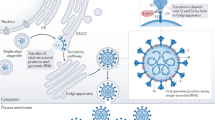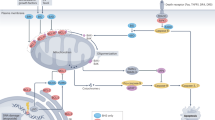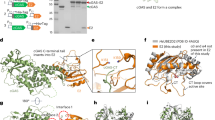Abstract
During their intraerythrocytic development, malaria parasites export hundreds of proteins to remodel their host cell. Nutrient acquisition, cytoadherence and antigenic variation are among the key virulence functions effected by this erythrocyte takeover. Proteins destined for export are synthesized in the endoplasmic reticulum (ER) and cleaved at a conserved (PEXEL) motif, which allows translocation into the host cell via an ATP-driven translocon called the PTEX complex. We report that plasmepsin V, an ER aspartic protease with distant homology to the mammalian processing enzyme BACE, recognizes the PEXEL motif and cleaves it at the correct site. This enzyme is essential for parasite viability and ER residence is essential for its function. We propose that plasmepsin V is the PEXEL protease and is an attractive enzyme for antimalarial drug development.
This is a preview of subscription content, access via your institution
Access options
Subscribe to this journal
Receive 51 print issues and online access
$199.00 per year
only $3.90 per issue
Buy this article
- Purchase on Springer Link
- Instant access to full article PDF
Prices may be subject to local taxes which are calculated during checkout






Similar content being viewed by others
References
Sargeant, T. J. et al. Lineage-specific expansion of proteins exported to erythrocytes in malaria parasites. Genome Biol. 7, R12 (2006)
van Ooij, C. et al. The malaria secretome: from algorithms to essential function in blood stage infection. PLoS Pathog. 4, e1000084 (2008)
Haldar, K. & Mohandas, N. Erythrocyte remodeling by malaria parasites. Curr. Opin. Hematol. 14, 203–209 (2007)
Maier, A. G., Cooke, B. M., Cowman, A. F. & Tilley, L. Malaria parasite proteins that remodel the host erythrocyte. Nature Rev. Microbiol. 7, 341–354 (2009)
Hiller, N. L. et al. A host-targeting signal in virulence proteins reveals a secretome in malarial infection. Science 306, 1934–1937 (2004)
Marti, M. et al. Targeting malaria virulence and remodeling proteins to the host erythrocyte. Science 306, 1930–1933 (2004)
Chang, H. H. et al. N-terminal processing of proteins exported by malaria parasites. Mol. Biochem. Parasitol. 160, 107–115 (2008)
Boddey, J. A., Moritz, R. L., Simpson, R. J. & Cowman, A. F. Role of the Plasmodium export element in trafficking parasite proteins to the infected erythrocyte. Traffic 10, 285–299 (2009)
Klemba, M. & Goldberg, D. E. Characterization of plasmepsin V, a membrane-bound aspartic protease homolog in the endoplasmic reticulum of Plasmodium falciparum . Mol. Biochem. Parasitol. 143, 183–191 (2005)
Tang, J. in Handbook of Proteolytic Enzymes 2nd edn, Vol. 1 (eds Barrett, A. J., Rawlings, N. D. & Woessner, J. F.) Ch. 13 (Elsevier, 2004)
Bhattacharjee, S. et al. The malarial host-targeting signal is conserved in the Irish potato famine pathogen. PLoS Pathog. 2, e50 (2006)
Russo, I., Oksman, A., Vaupel, B. & Goldberg, D. E. A calpain unique to alveolates is essential in Plasmodium falciparum and its knockdown reveals an involvement in pre-S-phase development. Proc. Natl Acad. Sci. USA 106, 1554–1559 (2009)
Klemba, M., Gluzman, I. & Goldberg, D. E. A Plasmodium falciparum dipeptidyl aminopeptidase I participates in vacuolar hemoglobin degradation. J. Biol. Chem. 279, 43000–43007 (2004)
Klemba, M., Beatty, W., Gluzman, I. & Goldberg, D. E. Trafficking of plasmepsin II to the food vacuole of the malaria parasite Plasmodium falciparum . J. Cell Biol. 164, 47–56 (2004)
Maier, A. G. et al. Exported proteins required for virulence and rigidity of Plasmodium falciparum-infected human erythrocytes. Cell 134, 48–61 (2008)
Kim, J. H. et al. Noninvasive measurement of the pH of the endoplasmic reticulum at rest and during calcium release. Proc. Natl Acad. Sci. USA 95, 2997–3002 (1998)
Boddey, J. A. et al. An aspartyl protease directs malaria effector proteins to the host cell. Nature 10.1038/nature08728 (this issue)
de Koning-Ward, T. F. et al. A newly discovered protein export machine in malaria parasites. Nature 459, 945–949 (2009)
Skinner-Adams, T. S. et al. Antiretrovirals as antimalarial agents. J. Infect. Dis. 190, 1998–2000 (2004)
Parikh, S. et al. Antimalarial activity of human immunodeficiency virus type 1 protease inhibitors. Antimicrob. Agents Chemother. 49, 2983–2985 (2005)
Russo, I., Oksman, A. & Goldberg, D. E. Fatty acid acylation regulates trafficking of the unusual Plasmodium falciparum calpain to the nucleolus. Mol. Microbiol. 72, 229–245 (2009)
Sullivan, D. J., Gluzman, I. Y. & Goldberg, D. E. Plasmodium hemozoin formation mediated by histidine-rich proteins. Science 271, 219–222 (1996)
Drew, M. E. et al. Plasmodium food vacuole plasmepsins are activated by falcipains. J. Biol. Chem. 283, 12870–12876 (2008)
Shevchenko, A., Wilm, M., Vorm, O. & Mann, M. Mass spectrometric sequencing of proteins silver-stained polyacrylamide gels. Anal. Chem. 68, 850–858 (1996)
Acknowledgements
This work was supported by NIH grant AI-047798. We thank A. Cowman, B. Crabb and S. Lindquist for suggestions, J. Adams and ATCC (MR4) for BiP antibody, D. Taylor for HRPII antibody, R. Anders for RESA antibody, A. Miller and M. Ndonwi for HRPII protein, P. Hruz for HIV protease inhibitors, J. Tang and S. Romeo for BACE inhibitors, W. Beatty for fluorescence analysis, S. Beverley for fluorimeter access, B. Vaupel for technical assistance and J. Turk for mass spectrometer access. Proteomics analysis was carried out at the ‘Fingerprints’ Proteomics Facility, College of Life Sciences, University of Dundee.
Author Contributions I.R. designed and executed most of the experiments and wrote the paper; S.B., V.M., T.B. and A.O. designed and executed experiments; D.E.G. designed experiments and wrote the paper.
Author information
Authors and Affiliations
Corresponding author
Ethics declarations
Competing interests
The authors declare no competing financial interests.
Supplementary information
Supplementary Information
This file contains Supplementary Figures 1-3 with Legends and Supplementary Table 1. (PDF 1194 kb)
Rights and permissions
About this article
Cite this article
Russo, I., Babbitt, S., Muralidharan, V. et al. Plasmepsin V licenses Plasmodium proteins for export into the host erythrocyte. Nature 463, 632–636 (2010). https://doi.org/10.1038/nature08726
Received:
Accepted:
Issue Date:
DOI: https://doi.org/10.1038/nature08726
This article is cited by
-
Tryptophan C-mannosylation is critical for Plasmodium falciparum transmission
Nature Communications (2022)
-
Maturation and substrate processing topography of the Plasmodium falciparum invasion/egress protease plasmepsin X
Nature Communications (2022)
-
Malaria protection due to sickle haemoglobin depends on parasite genotype
Nature (2022)
-
The parasitophorous vacuole of the blood-stage malaria parasite
Nature Reviews Microbiology (2020)
-
Clade 5 aspartic proteases of Phytophthora infestans are virulence factors implied in RXLR effector cleavage
European Journal of Plant Pathology (2019)
Comments
By submitting a comment you agree to abide by our Terms and Community Guidelines. If you find something abusive or that does not comply with our terms or guidelines please flag it as inappropriate.



